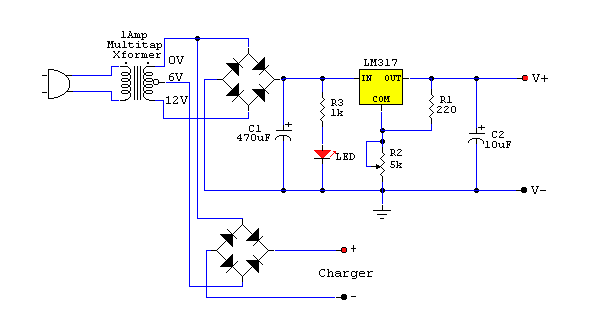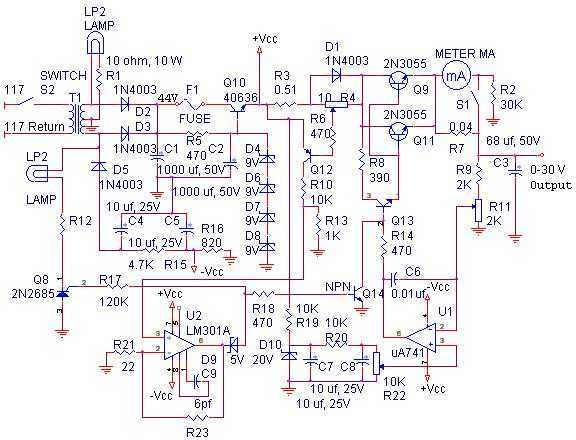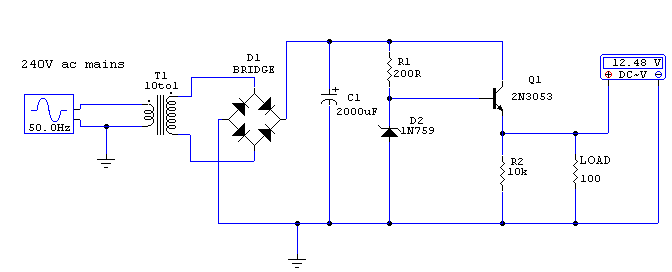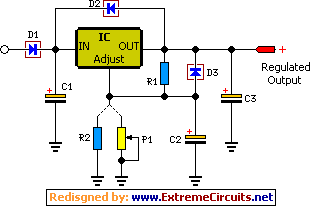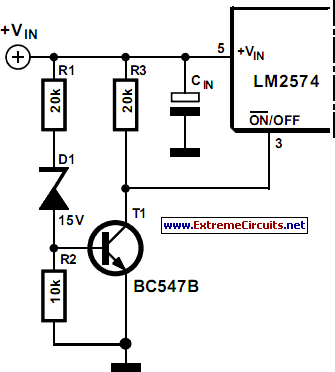
Supply Voltage Indicator
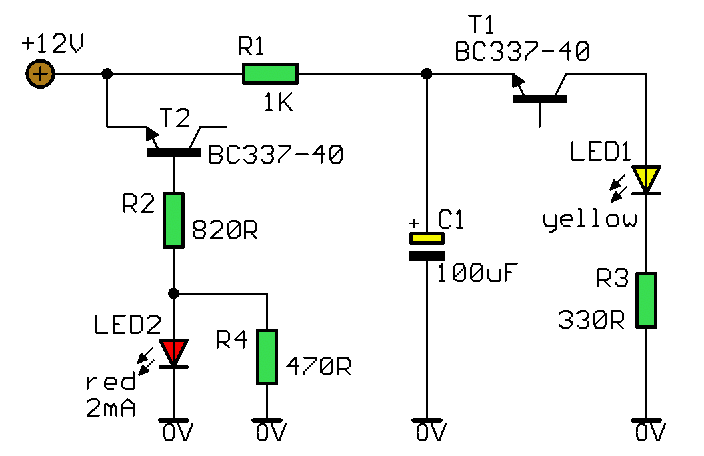
This circuit clearly indicates the supply voltage level in a larger device. When the indicator receives a stable 12 volts, LED1 emits a steady yellow light. If the input voltage drops below 11 volts, LED1 begins to blink, with the frequency of blinking decreasing as the voltage continues to fall. The blinking stops, and LED1 turns off when the voltage falls below 9 volts. Conversely, if the input voltage rises to 13 volts, LED2 lights up, reaching near full brightness at 14 volts. The specific voltage thresholds can be adjusted primarily by changing the values of resistors R1 and R4. The base-emitter junction of transistor T2 functions similarly to a zener diode. The emitter-collector pathway of transistor T1 is inversely biased, and when the input voltage is sufficiently high, T1 induces oscillations, with the frequency of these oscillations being proportional to the input voltage. The relaxation oscillator stops functioning when the input voltage drops too low to maintain breakdown in the emitter-collector path. Not all small NPN transistors exhibit this behavior under inverse bias, but many do. The BC337-40 transistor can initiate oscillations at relatively low voltages, while other types may require a slightly higher voltage. Caution is advised to avoid damaging the device under test, as oscillations typically occur between 9 to 12 volts.
The circuit employs a simple yet effective design to monitor supply voltage levels through visual indicators. The primary components include two light-emitting diodes (LED1 and LED2), two resistors (R1 and R4), and two NPN transistors (T1 and T2). LED1 serves as the primary indicator for voltage levels below 12 volts, providing a clear visual cue through steady illumination or blinking to represent the decreasing voltage. The blinking frequency of LED1 acts as an intuitive gauge for the user, allowing for quick assessment of the supply voltage status.
Transistor T1 operates in a unique manner when subjected to inverse bias; it can generate oscillations within a specific voltage range. This behavior is leveraged to create a relaxation oscillator, which is an essential aspect of the circuit. The oscillation frequency is directly related to the input voltage, providing a dynamic response to voltage changes. The use of the BC337-40 transistor is particularly effective due to its capability to initiate oscillations at lower voltages compared to other NPN transistors, making it suitable for this application.
The circuit's design allows for easy adjustment of voltage thresholds through the selection of resistor values. By modifying R1 and R4, the user can customize the voltage levels at which LED1 and LED2 respond, tailoring the circuit to specific requirements. This flexibility makes the circuit versatile for various applications where monitoring supply voltage is critical.
In summary, this circuit serves as a reliable and straightforward method for visualizing supply voltage levels, incorporating adjustable thresholds and utilizing the unique characteristics of NPN transistors to provide real-time feedback on voltage status. The combination of steady and blinking LED indicators, along with the ability to adjust voltage sensitivity, makes this circuit an effective tool for monitoring electrical devices.This simple and slightly odd circuit can clearly show the level of the supply voltage (in a larger device): as long as the indicator has good 12 volts at its input, LED1 gives steady, uninterrupted (for the naked eye) yellow light. If the input voltage falls below 11 V, LED1 will start to blink and the blinking will just get slower and slower if t
he voltage drops further - giving very clear and intuitive representation of the supplys status. The blinking will stop and LED1 will finally go out at a little below 9 volts. On the other hand, if the input voltage rises to 13 V, LED2 will start to glow, getting at almost full power at 14 V. The characteristic voltages can be adjusted primarily by adjusting the values of R1 and R4. The base-emitter diode of T2 basically just stands in for a zener diode. The emitter-collector path of T1 is inversely polarized and if the input voltage is high enough - T1 will cause oscillations and the frequency will be proportional to the input voltage.
The relaxation oscillator ceases cycling when the input voltage gets so low that it no longer can cause breakdown along the emitter-collector path. Not all small NPN transistors show this kind of behavior when inversely polarized in a similar manner, but many do.
BC337-40 can start oscillations at a relatively low voltage, other types generally require a volt or two more. If experimenting, be careful not to punch a hole through the device under test: they oscillate at 9-12 V or not at all.
🔗 External reference
The circuit employs a simple yet effective design to monitor supply voltage levels through visual indicators. The primary components include two light-emitting diodes (LED1 and LED2), two resistors (R1 and R4), and two NPN transistors (T1 and T2). LED1 serves as the primary indicator for voltage levels below 12 volts, providing a clear visual cue through steady illumination or blinking to represent the decreasing voltage. The blinking frequency of LED1 acts as an intuitive gauge for the user, allowing for quick assessment of the supply voltage status.
Transistor T1 operates in a unique manner when subjected to inverse bias; it can generate oscillations within a specific voltage range. This behavior is leveraged to create a relaxation oscillator, which is an essential aspect of the circuit. The oscillation frequency is directly related to the input voltage, providing a dynamic response to voltage changes. The use of the BC337-40 transistor is particularly effective due to its capability to initiate oscillations at lower voltages compared to other NPN transistors, making it suitable for this application.
The circuit's design allows for easy adjustment of voltage thresholds through the selection of resistor values. By modifying R1 and R4, the user can customize the voltage levels at which LED1 and LED2 respond, tailoring the circuit to specific requirements. This flexibility makes the circuit versatile for various applications where monitoring supply voltage is critical.
In summary, this circuit serves as a reliable and straightforward method for visualizing supply voltage levels, incorporating adjustable thresholds and utilizing the unique characteristics of NPN transistors to provide real-time feedback on voltage status. The combination of steady and blinking LED indicators, along with the ability to adjust voltage sensitivity, makes this circuit an effective tool for monitoring electrical devices.This simple and slightly odd circuit can clearly show the level of the supply voltage (in a larger device): as long as the indicator has good 12 volts at its input, LED1 gives steady, uninterrupted (for the naked eye) yellow light. If the input voltage falls below 11 V, LED1 will start to blink and the blinking will just get slower and slower if t
he voltage drops further - giving very clear and intuitive representation of the supplys status. The blinking will stop and LED1 will finally go out at a little below 9 volts. On the other hand, if the input voltage rises to 13 V, LED2 will start to glow, getting at almost full power at 14 V. The characteristic voltages can be adjusted primarily by adjusting the values of R1 and R4. The base-emitter diode of T2 basically just stands in for a zener diode. The emitter-collector path of T1 is inversely polarized and if the input voltage is high enough - T1 will cause oscillations and the frequency will be proportional to the input voltage.
The relaxation oscillator ceases cycling when the input voltage gets so low that it no longer can cause breakdown along the emitter-collector path. Not all small NPN transistors show this kind of behavior when inversely polarized in a similar manner, but many do.
BC337-40 can start oscillations at a relatively low voltage, other types generally require a volt or two more. If experimenting, be careful not to punch a hole through the device under test: they oscillate at 9-12 V or not at all.
🔗 External reference
